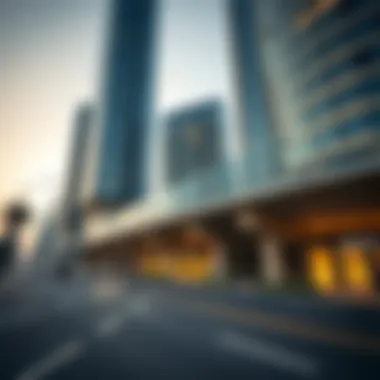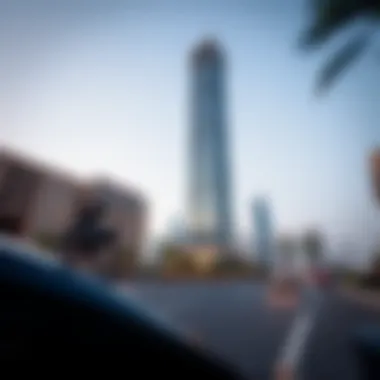Find Your Way to Latifa Tower on Sheikh Zayed Road


Intro
Navigating to an iconic location like Latifa Tower on Sheikh Zayed Road requires a blend of local knowledge and an understanding of the broader context within Dubai's urban landscape. As one of the most prominent skyscrapers, Latifa Tower is not just a structure; it represents the pulse of the city. The tower's strategic location signifies its importance in Dubai's ever-growing real estate market and offers a gateway for both residents and visitors alike.
The bustling Sheikh Zayed Road is the lifeblood of Dubai, connecting key neighborhoods and commercial hubs. For anyone looking to reach Latifa Tower, whether for business or leisure, understanding how to maneuver through the area can make the journey less daunting and more enjoyable. This guide will cover various transport options, insider tips, and essential information that can simplify your visit.
In this article, we will delve into some of the finer points of navigating to Latifa Tower, highlighting both public transport systems and convenient road routes. We aim to equip you with all the knowledge you need, ensuring a seamless experience as you explore one of Dubai's key landmarks. And as we traverse this journey, we will also touch upon elements highlighting the property landscape surrounding Latifa Tower, making this guide relevant for real estate investors, homebuyers, and other stakeholders in Dubai's vibrant market.
"Understanding how to navigate the urban sprawl is as crucial as knowing your destination."
The following sections will cover essential tips on public transport, strategic driving routes, and insights into the property market trends specifically related to Sheikh Zayed Road. Let's join the journey and make reaching Latifa Tower as smooth as possible.
Prologue to Latifa Tower
Latifa Tower stands as a beacon of modern architecture and a symbol of Dubai's skyline. This prominent structure, situated on the bustling Sheikh Zayed Road, exemplifies the fusion of innovative design and practical functionality, making it a vital landmark not only for its aesthetic appeal but also for its role in the everyday lives of the city’s inhabitants and visitors alike.
In this guide, we delve into the intricacies of reaching Latifa Tower, emphasizing its importance as both a business hub and a residential space. Understanding how to navigate to this tower can provide seamless access to its various amenities.
Significance of Latifa Tower
Latifa Tower is more than just a tall building; it's a crucial part of Dubai's economic narrative. Positioned in a prime location, it accommodates numerous corporate offices and offers high-quality residential units. For investors, this is a hotspot, with ongoing developments promising growth in property value. Moreover, the tower is symbolic of Dubai's ambition to design structures that are not only eye-catching but also functional.
Many regard Latifa Tower as a crucial point in Dubai’s rapidly evolving skyline, mirroring the city’s relentless pursuit of modernity. It’s a location that attracts local and international businesses alike, solidifying its place as a hub for commerce and connectivity.
Architectural Features
The design of Latifa Tower is a reflection of contemporary architectural trends, blending functionality with aesthetic elegance. Its sleek façade often catches the eye of those traveling along Sheikh Zayed Road. The tower rises prominently, characterized by its unique curves and striking glass exterior, which not only enhances its visual appeal but also contributes to energy efficiency.
Internally, the tower is just as remarkable. Spacious office environments with state-of-the-art facilities are supplemented by residential apartments that offer panoramic views of the city. The emphasis on green space is notable, with well-planned landscaping that provides a more serene atmosphere amidst the urban bustle. This balance of design and utility positions Latifa Tower as an example of thoughtful urban development, one that future projects will likely emulate.
Overview of Sheikh Zayed Road
Sheikh Zayed Road stands as a vital artery in Dubai, connecting the emirate’s bustling districts and serving as a gateway to numerous attractions. It’s not just a road; it’s a representation of the city itself—dynamic, always in motion, and integral to both daily commutes and tourist travels. This thoroughfare directly influences access to significant landmarks, including Latifa Tower, thus becoming an essential focus in any guide aimed at understanding how to navigate Dubai.
Understanding the importance of Sheikh Zayed Road goes beyond just recognizing its physical layout. It plays a pivotal role in the wider context of Dubai’s urban development, acting as a backbone for commercial activities and residential growth. This road has evolved over the decades, adapting to the ever-changing needs of the city’s population.
Historical Context
Sheikh Zayed Road’s history traces back to the early days of Dubai's transformation from a small fishing village to a global metropolis. Originally known as Al-Diwan Street, it was renamed in honor of Sheikh Zayed bin Sultan Al Nahyan, the founding father of the United Arab Emirates. The establishment of this highway can be seen as a reflection of Dubai’s aspirations towards modernization and economic expansion.
As Dubai began to develop its infrastructure in the late 1970s and early 1980s, Sheikh Zayed Road was developed to ease transportation, connecting various parts of the city. The growth of skyscrapers along the road, including the iconic Burj Khalifa and Latifa Tower, signifies the architectural ambition that characterized Dubai's rapid development. When specific projects, such as the Dubai International Financial Centre (DIFC), emerged, the road became crucial for facilitating the movement of goods and people to and from these burgeoning commercial hubs.
Economic Importance
The economic significance of Sheikh Zayed Road cannot be overstated. This thoroughfare stands as a vital commercial corridor, housing a mix of high-profile businesses, hotels, and commercial outlets that attract both local and international visitors. The road is flanked by major residential developments, making it an attractive location for investors and homebuyers, which in turn boosts the property market in Dubai.
Moreover, the accessibility of Sheikh Zayed Road facilitates trade and tourism, playing host to a steady flow of traffic that nurtures local economies. The various exhibitions, conferences, and events often held in this part of the city bring substantial revenue not only to the businesses along the road, but also enhance the attractiveness of Dubai on the global stage.
Sheikh Zayed Road is more than just a thoroughfare; it symbolizes Dubai's unwavering commitment to growth and innovation.
Understanding its historical context and economic impact provides critical insights for potential investors and those navigating the real estate market. The successful integration of high-end retail, hospitality options, and residential units creates a vibrant environment that is both appealing to residents and profitable for business owners. When planning a trip to Latifa Tower, grasping the nuanced dynamics of Sheikh Zayed Road enhances the overall experience, elevating it beyond mere travel into something more significant.


Transportation Options to Latifa Tower
When embarking on a journey to Latifa Tower, understanding the transportation options available is vital. This not only eases the travel experience but also allows for higher efficiency and convenience. Whether you are a resident or a first-time visitor, the right choice of transport can enhance your overall experience in Dubai.
Public Transportation
Public transportation is a cornerstone of connectivity in Dubai. It presents an accessible and cost-effective means to reach various landmarks, with Latifa Tower being a prominent destination. Here are some of the options:
Metro Access
One of the standout features of Dubai's public transport system is the Metro. The Red Line of the Dubai Metro is especially noteworthy as it provides direct access to Latifa Tower. Situated close to other prominent locations, it marks itself as a popular choice due to its efficiency. Trains arrive every few minutes, allowing for minimal waiting time, which makes it somewhat reliable.
Unique Feature: The metro often runs above ground, allowing passengers to enjoy stunning views of Dubai’s skyline during their commute.
Advantages: The affordability and speed of the metro cannot be overlooked. With a simple tap of a Nol card, you can be whisked away to your destination without the hassles of traffic or parking.
Disadvantages: However, peak hours can see crowded trains, which might be a discomfort for some.
Bus Routes
Buses are another pivotal piece of the public transport puzzle. Numerous bus routes service the Dubai area, including direct buses to Latifa Tower. This mode of transport stands to serve those who prefer flexibility over speed, as buses often take slightly longer.
Unique Feature: Certain bus stops are strategically located near shopping areas and restaurants, making it convenient for travelers to combine errands with their journey.
Advantages: The biggest plus here is cost; bus fares are generally lower than taxi rides. If you’ve got the time, taking the bus can be a budget-friendly option.
Disadvantages: Do bear in mind that buses may have limited schedules late at night, and waiting times can vary more than those of the Metro.
Taxi Services
For those opting for convenience, taxi services stand as a prominent choice. Taxis in Dubai are well-regulated and known for their comfort. They can be hailed on the street or booked via mobile apps, making them readily accessible.
Unique Feature: Taxi drivers often have a wealth of knowledge regarding the city, offering insider tips and shortcuts that can enhance your travel experience.
Advantages: Taxis provide door-to-door service, which is especially useful for visitors who may not know the area well. Plus, you can avoid the rigmarole of public transport schedules.
Disadvantages: Taxi fares are significantly higher compared to public transit options, particularly for long distances or during peak hours.
Driving Directions
Many choose to drive to Latifa Tower for the sake of convenience. Familiarity with the area's roads is key, as it can alleviate potential confusion.
Navigating from Downtown
Driving from Downtown Dubai to Latifa Tower is straightforward. You'll head along Sheikh Zayed Road, a major artery through the city. As you reach Latifa Tower, clear signage guides you through to ensure a smooth arrival. This route, for those familiar with it, is useful in avoiding some of the busier side streets.
Advantages: The primary benefit here is the speed of travel, especially during off-peak hours.
Disadvantages: However, rush hour traffic can be a real headache, leading to delays that can be frustrating.
Access from Dubai Marina


If you're coming from Dubai Marina, the route takes you directly onto Sheikh Zayed Road. The journey offers scenic views of the marina and the iconic structures along the coast.
Advantages: You can enjoy the beautiful skyline as you drive, which is quite appealing.
Disadvantages: Heavy traffic in this area can slow down your journey during busy times.
Local Traffic Considerations
Being aware of local traffic patterns is essential. In times of events or holidays, traffic may be significantly heavier.
Consideration Tip: Using navigation apps can aid in avoiding traffic jams and ensure you have the quickest route covered.
In summary, navigating to Latifa Tower involves a mix of public transport options and driving considerations, all of which contribute to allowing smooth access to this landmark. Whatever your choice, being informed certainly enhances your experience.
Walking Directions from Key Locations
Navigating on foot to Latifa Tower can be enriching, especially for those exploring the heart of Dubai. Walking not only offers a unique perspective of the city but also provides a chance to interact with the vibrant life surrounding Sheikh Zayed Road. For residents and visitors alike, having a clear understanding of key walking routes from popular locales enhances the overall experience and ensures easy accessibility to this iconic structure.
From Dubai Mall
Starting from Dubai Mall, one of the world's most famous shopping destinations, the walk to Latifa Tower is straightforward but visually stimulating. Exit the mall at the main entrance and face the Burj Khalifa. Head towards the Dubai Fountain and proceed through Mohammed Bin Rashid Boulevard. As you amble along the boulevard, keep your eyes peeled for art installations and the stunning views of the Burj. The walk is approximately 2 kilometers and typically takes around 25 minutes.
- Stay on the marked pedestrian paths.
- Watch for cycle lanes; they add to the vibrancy of the route.
- Enjoy various shops and cafes along the way, perfect for a quick coffee break.
From Burj Khalifa
Walking from Burj Khalifa is an equally engaging journey. As you step outside the iconic structure, head south towards the intersection of Sheikh Mohammed Bin Rashid Boulevard and Sheikh Zayed Road. Crossing the road can be busy, so utilize the pedestrian crossings and signals. This route will cover about 1.5 kilometers, taking roughly 20 minutes.
"Walking is a wonderful way to connect with the city's heart, especially with such stunning architecture surrounding you."
Consider these tips:
- Early mornings or late afternoons lend captivating light for photographs.
- Stay hydrated, especially during the hotter months.
- Be mindful of pedestrians and cyclists sharing the paths.
From Business Bay
The journey from Business Bay to Latifa Tower represents an exploration of Dubai’s upscale modern communities. As you exit Business Bay, head towards the waterfront promenade. You can take the waterway route, enjoying the stunning city skyline reflected in the water, or opt for the main roads. This leisurely stroll is also about 2 kilometers long and would generally take around 30 minutes.
- The waterfront offers ample seating and shade—a perfect spot for relaxation before or after your walk.
- Look out for various public art pieces that dot the area.
- The route may be slightly longer if you choose to meander through smaller side streets, which offer a glimpse into local life.
Emphasizing pedestrian accessibility enhances the overall experience of reaching Latifa Tower. As Dubai continues to prioritize walkability, the connections between major landmarks are increasingly user-friendly.
Navigating Surrounding Areas
Getting to Latifa Tower is just half the story; understanding the surroundings is equally important. This section delves into the various elements that make the areas surrounding Latifa Tower not just convenient, but also enriching for anyone visiting or residing in the vicinity.
Parking Facilities
When considering a visit to Latifa Tower, knowing where to park can save time and frustration. The tower's location on Sheikh Zayed Road means ample parking options exist but they can fill up fast, especially during peak hours. Most places offer valet services, although self-parking is also available. The Latifa Tower Parking is convenient, but its relatively high usage means finding a spot can sometimes feel like searching for a needle in a haystack. It's wise to plan ahead; arriving early can make a significant difference.
Nearby Amenities


The area surrounding Latifa Tower is bustling with amenities that cater to a variety of needs and preferences. Here’s a closer look at three key categories: dining options, shopping centers, and recreational areas.
Dining Options
Restaurants near Latifa Tower offer diverse cuisines, ticking the boxes for taste and atmosphere. For instance, you’ll find everything from street food to fine dining within a short walking distance. One standout is Zuma, known for its contemporary Japanese dishes, which add a luxe vibe to any dining experience. The lively atmosphere contributes positively to a visit, making it a favored choice. However, reservations are recommended due to its popularity. It’s worth noting that options range from budget-friendly bites to high-end meals, accommodating a spectrum of tastes and budgets.
Shopping Centers
Shopping is another highlight in this area. Dubai Mall, one of the largest shopping centers globally, isn’t just a shopping haven; it’s an experience. Its sheer scale and variety of retail outlets attract both locals and tourists. Whether you’re hunting for designer brands or unusual local products, this place has it. The disadvantage? Navigating through throngs of shoppers can be overwhelming at times. Still, the sheer entertainment value and diverse offerings make it worthwhile.
Recreational Areas
Lastly, recreational areas around Latifa Tower provide a refreshing escape amid the urban hustle. Dubai Opera Garden stands out with its spectacular aesthetic and peaceful ambiance. This open space is perfect for an evening stroll or a family picnic. Outdoor activities are easily accessible, making it a popular spot for families. The only downside might be its popularity; it can become quite busy on weekends, affecting the tranquility often sought in parks.
In summary, successfully navigating the surrounding areas of Latifa Tower opens up a wealth of opportunities. Whether you’re looking to park, enjoy a meal, shop, or unwind, this locale has something to offer. Prioritizing understanding these aspects not only enriches a visit but also enhances the overall experience.
Challenges and Considerations
When contemplating a visit to Latifa Tower on Sheikh Zayed Road, it's crucial to address the myriad of challenges that visitors may face. Understanding these potential hurdles can greatly improve one's experience, allowing for a smoother journey and better overall planning.
Traffic Patterns
One of the primary difficulties in navigating to Latifa Tower is the traffic patterns commonly encountered along Sheikh Zayed Road. With it being one of Dubai's busiest highways, heavy congestion is not an uncommon sight, especially during peak hours. Knowing when to travel can save precious time.
- Peak Hours: Morning rush hour typically spans from 7:30 AM to 9:30 AM, and evening commutes peak from 5:00 PM to 7:00 PM. If possible, aim for mid-mornings or late evenings to sidestep heavy traffic.
- Real-Time Traffic Updates: Utilize navigation apps like Google Maps or Waze which provide live traffic updates. This can direct you around bottlenecks that might spring up unexpectedly.
- Diversion Routes: Be familiar with alternate routes. The Al Khail Road and Sheikh Mohammed Bin Zayed Road may offer alternative paths to skirt around gridlock.
Being ready for traffic challenges can transform a stressful commute into a more manageable outing, facilitating a timely arrival to experience the majestic Latifa Tower.
Construction Developments
Another layer of complexity arises from the ongoing construction developments in the vicinity of Sheikh Zayed Road. As the city continues to expand and improve, temporary road closures or diversions become a common occurrence. This aspect necessitates a degree of adaptability and forward-thinking.
- Check Local Notices: Prior to setting out, investigate local news or community boards—these sources frequently publish updates on road work that could impact traffic.
- Deciphering Detours: When there's construction, detours can sometimes lead drivers into unfamiliar territory. Familiarizing oneself with key landmarks along the suggested detours can mitigate confusion.
- Safety Awareness: Be extra cautious around construction zones. Workers and equipment could be present, requiring drivers to stay vigilant.
Navigating construction activity can be an exercise in patience, but with enough preparation, it can be tackled successfully.
In essence, being prepared for both traffic patterns and construction developments is essential when planning a trip to Latifa Tower. These elements can significantly affect accessibility and should be considered part of the overall journey, not mere obstacles. By incorporating awareness of these aspects, visitors can enjoy their visit with fewer stresses.
Closure
As we wrap up this guide, it’s crucial to reflect on the essential aspects of reaching Latifa Tower on Sheikh Zayed Road. Understanding the various modes of transportation, walking routes, and potential challenges involved plays a significant role in ensuring a smooth visit. The intersection of historical significance and modern convenience embodied by Latifa Tower is not just a structural marvel; it embodies a space where business meets culture, making it pivotal for both the curious visitor and the determined investor.
Recap of Directions
In summary, getting to Latifa Tower isn’t just about turning on the navigation app. Let’s revisit the key steps to ensure your journey is seamless:
- By Metro: Board the Red Line and alight at the Burj Khalifa/Dubai Mall station. From there, a short walk through the mall or along the scenic canals brings you to Latifa Tower.
- By Bus: Several buses from key areas like Dubai Marina or Deira head towards Sheikh Zayed Road, and the bus stops are conveniently located near the Tower.
- Driving: Navigate from Downtown by heading straight down Mohammed Bin Rashid Boulevard and merging onto Sheikh Zayed Road. Use landmarks like the Dubai Aquarium as your guide.
"Whether you’re commuting for work or exploring the unique architectural beauty, knowing your directions is half the battle."
Importance of Accessibility
Accessibility is not merely a luxury; it’s a necessity in today’s fast-paced urban environment. The ability to navigate effortlessly to Latifa Tower directly reflects its importance as a central hub of activity in Dubai. For investors and homebuyers alike, proximity to such landmarks increases property value, confirming the area’s viability. Moreover, ease of access ensures that Latifa Tower isn’t just a destination; it becomes an integral part of one’s daily routine.
Additionally, facilities for parking and public transport have improved significantly, reflecting not just on urban planning but also on the commitment to creating a welcoming environment. As the city continues to grow, well-planned accessibility will remain a cornerstone in enhancing the experience of residents and visitors alike.
Whether you are a savvy investor looking for opportunities or a curious traveler wanting to soak in the Dubai skyline, navigating to Latifa Tower via Sheikh Zayed Road will undoubtedly reveal the interconnectedness of culture, commerce, and convenience.







